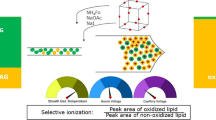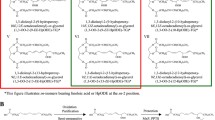Abstract
Oxidation is the major cause of fat and oil deterioration which produces rancid and unpleasant flavors that drastically reduces their quality and nutritional value. The primary oxidation products are triacylglycerols (TAG) containing unsaturated fatty acyl hydroperoxides formed by a chain process occurring through free radical intermediates. The Rancimat method is currently the gold standard for measuring the oxidative stability of oils and fats. In this report, easy ambient sonic-spray ionization mass spectrometry (EASI-MS) is demonstrated to function as a direct (no pre-separation or sample preparation steps), fast and accurate method to monitor oils and fats oxidation, providing detailed overviews of the most immediate TAG hydroperoxide products. The EASI-MS results were compared to those obtained via the classical Rancimat test.





Similar content being viewed by others
References
Frankel EN (1984) Lipid oxidation: mechanisms, products and biological significance. J Am Oil Chem Soc 61:1908–1917
Kinter M (1995) Analytical technologies for lipid oxidation products analysis. J Chromatogr B 671:223–236
Gray JI (1984) Measurement of lipid oxidation: a review. J Am Oil Chem Soc 55:539–546
Frankel EN (2005) Stability methods. In: Lipid oxidation, 2nd edn. The Oily Press, Bridgwater, pp 165–186
Dobarganes MC (2002) Analysis of lipid hydroperoxides. Eur J Lipid Sci Technol 104:420–428
AOCS (1996) Method Cd 8b-90. In: Official methods and recommended practices of the American Oil Chemist’s Society. AOCS, Champaign
Hughes H, Smith CV, Tsokos-Kuhn JO, Mitchel JR (1983) Quantification of lipid peroxidation products by gas chromatography–mass spectrometry. Anal Biochem 130:431–436
Bauer-Plank C, Steenhorst-Slikkerveer L (2000) Analysis of triacylglycerol hydroperoxides in vegetable oils by non-aqueous reversed-phase high-performance liquid chromatography with ultraviolet detection. J Am Oil Chem Soc 77:477–482
Steenhorst-Slikkerveer L, Louter A, Janssen H-G, Bauer-Plank C (2000) Analysis of nonvolatile lipid oxidation products in vegetable oils by normal-phase high-performance liquid chromatography with mass spectrometric detection. J Am Oil Chem Soc 77:837–845
Neff WE, Byrdwell WC (1998) Characterization of model triacylglycerol (triolein, trilinolein and trilinolenin) autoxidation products via high-performance liquid chromatography coupled with atmospheric pressure chemical ionization mass spectrometry. J Chromatogr A 818:169–186
Haddad R, Sparrapan R, Eberlin MN (2006) Desorption sonic spray ionization for (high) voltage-free ambient mass spectrometry. Rapid Commun Mass Spectrom 20:2901–2905
Haddad R, Sparrapan R, Kotiaho T, Eberlin MN (2008) Easy ambient sonic-spray ionization-membrane interface mass spectrometry for direct analysis of solution constituents. Anal Chem 80:898–903
Haddad R, Milagres HMS, Catharino RR, Eberlin MN (2008) Easy ambient sonic-spray ionization mass spectrometry combined with thin-layer chromatography. Anal Chem 80:2744–2750
Venter A, Nefliu M, Cooks RG (2008) Ambient desorption ionization mass spectrometry. Trends Anal Chem 27:284–290
Harris GA, Nyadong L, Fernandez FM (2008) Recent development in ambient ionization techniques for analytical mass spectrometry. Analyst 133:1297–1301
Van Berkel GJ, Pasilis SP, Ovchinnikova O (2008) Established and emerging atmospheric pressure surface sampling/ionization techniques for mass spectrometry. J Mass Spectrom 43:1161–1180
Chen H, Gamez G, Zenobi R (2009) What can we learn from ambient ionization techniques? J Am Soc Mass Spectrom 20:1947–1963
Weston DJ (2010) Ambient ionization mass spectrometry: current understanding of mechanistic theory; analytical performance and applications areas. Analyst 135:661–668
Ifa DR, Wu C, Ouyang Z, Cooks RG (2010) Desorption electrospray ionization and other ambient ionization methods: current progress and preview. Analyst 135:669–681
Alberici RM, Simas RC, Sanvido GB, Romão W, Lalli PM, Benassi M, Cunha IBS, Eberlin MN (2010) Ambient mass spectrometry: bringing MS into the real world. Anal Bional Chem 398:265–294
Hirabayashi A, Sakairi M, Koizumi H (1995) Sonic spray mass spectrometry. Anal Chem 67:2878–2882
Hirabayashi A, Hirabayashi Y, Sakairi M, Koizumi H (1996) Multiply-charged ion formation by sonic spray. Anal Rapid Commun Mass Spectrom 10:1703–1705
Simas RC, Catharino RR, Cunha IBS, Cabral EC, Barrera-Arellano D, Eberlin MN, Alberici RM (2010) Instantaneous characterization of vegetable oils via TAG and FFA profiles by easy ambient sonic-spray ionization mass spectrometry. Analyst 135:735–744
Abdelnur PV, Eberlin LS, Sá GF, Souza V, Eberlin MN (2008) Single-shot biodiesel analysis: nearly instantaneous typification and quality control solely by ambient mass spectrometry. Anal Chem 80:7882–7886
Eberlin LS, Abdelnur PV, Passero A, Sá GF, Souza V, Daroda RJ, Eberlin MN (2009) Analysis of biodiesel and biodiesel-petrodiesel blends by high performance thin layer chromatography combined with easy ambient sonic-spray ionization mass spectrometry. Analyst 134:1652–1657
Alberici RM, Simas RC, Souza V, de Sá GF, Daroda RJ, Eberlin MN (2010) Analysis of fuels via easy ambient sonic-spray ionization mass spectrometry. Anal Chim Acta 659:15–22
Alberici RM, Simas RC, Abdelnur PV, Eberlin MN, Souza V, de Sá GF, Daroda RJ (2010) A highly effective antioxidant and artificial marker for biodiesel. Energy Fuels 24:6522–6526
Riccio MF, Sawaya ACHF, Abdelnur PV, Saraiva SA, Haddad R, Eberlin MN, Catharino RR (2011) Easy ambient sonic-spray ionization mass spectrometric of olive oils: quality control and certification of geographical origin. Anal Lett 44:1489–1497
Liang C, Schwarzer K (1998) Comparison of four accelerated stability methods for lard and tallow with and without antioxidants. J Am Oil Chem Soc 75:1441–1443
Neff WE, El-Agaimy M (1996) Autoxidation of trioleoylglycerol. Oleagineux Corps Gras Lipides 3:71–74
Acknowledgments
We thank the State of São Paulo Research Foundation (FAPESP), the Brazilian National Council for Scientific and Technological Development (CNPq) and the Financing Agency of Studies and Projects (FINEP) for financial assistance. We also thank Dra Carmen Dobarganes for suggestions and revision of this manuscript.
Author information
Authors and Affiliations
Corresponding author
About this article
Cite this article
Simas, R.C., Barrera-Arellano, D., Eberlin, M.N. et al. Triacylglycerols Oxidation in Oils and Fats Monitored by Easy Ambient Sonic-Spray Ionization Mass Spectrometry. J Am Oil Chem Soc 89, 1193–1200 (2012). https://doi.org/10.1007/s11746-012-2010-5
Received:
Revised:
Accepted:
Published:
Issue Date:
DOI: https://doi.org/10.1007/s11746-012-2010-5




